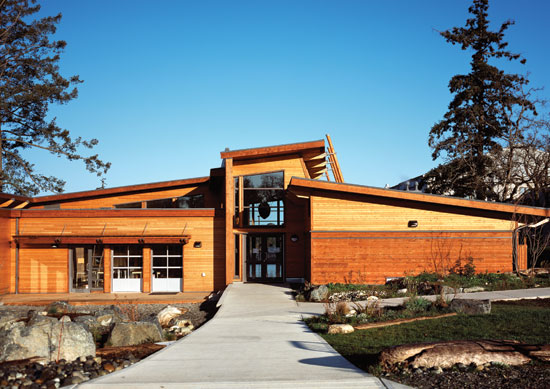Growing Bolder: Specifying Western Red Cedar for Architectural Applications
Learning Objectives:
- List the grades and standards applied to Western Red Cedar, explaining their impacts on appearance, durability and environmental qualities.
- Describe the differences and benefits of using Western Red Cedar clear grades and knotty grades, including their resilience and sustainability benefits.
- Discuss the applications and situations in which one can specify clear or knotty Western Red Cedar, or both, such as for siding, trims, decking and interiors.
- Explain using case studies how Western Red Cedar has been used to achieve architectural and green building objectives.
Credits:
A number of related trends in architectural design today are contributing to a growing use of Western Red Cedar (sometimes called “red cedar” or “western redcedar”), a wood species that can present a number of performance advantages. Yet, like many natural materials, the general classification Western Red Cedar comprises a large range of potential traits and application options. Various grades, colors, patterns, and cut techniques account for much of the variety in use and design expression.
One segment of the grades spectrum for Western Red Cedar is clear, which displays a relatively “limited number of natural characteristics” according to RealCedar.com.1 Clear grades are considered to be high-quality products, and for siding or trim, for example, they are normally supplied kiln-dried.
Contrasting with the clear variants is knotty cedar, also supplied kiln-dried, which offers more variety in visual characteristics and appearance and can be used to present a finish that is more textured and biomorphic. Described by designers as “smart casual,” “rustic,” and “optical,” knotty cedar grades are also available for some light structural applications. Dimensional sizes of Western Red Cedar for light framing and structural joists and planks are typically kiln-dried or unseasoned.
Consideration of the use of knotty cedar opens doors to new design expression for architects, including those who use clear grades of Western Red Cedar in other projects—or in the same buildings and interiors alongside the other grades. Recent examples include the downtown Seattle storefront of retailer Columbia Sportswear, designed by Boston's Bergmeyer Associates (with Raja Slate tiles), or the award-winning Lobster Boat Residence on Seattle's Portage Bay by Chadbourne + Doss Architects, with the latter displaying both exterior and interior applications. The knots—left by the base of a side branch or a dormant bud, yielding areas of hardened, darkened wood in roughly circular patterns around which the grain direction flows—can be exploited for a number of visual effects.

Photo courtesy of WRCLA
For students on the South Saanich Indian Reserve on Vancouver Island, an addition to Saanich Indian School Board (SISB) is clad in Western Red Cedar siding and trims with posts and landscape elements.










